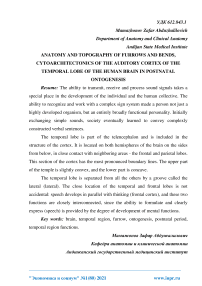Anatomy and topography of furrows and bends, cytoarchitectonics of the auditory cortex of the temporal lobe of the human brain in postnatal ontogenesis
Автор: Mamazhonov Z.A.
Журнал: Экономика и социум @ekonomika-socium
Рубрика: Основной раздел
Статья в выпуске: 1-1 (80), 2021 года.
Бесплатный доступ
The ability to transmit, receive and process sound signals takes a special place in the development of the individual and the human collective. The ability to recognize and work with a complex sign system made a person not just a highly developed organism, but an entirely broadly functional personality. Initially exchanging simple sounds, society eventually learned to convey complexly constructed verbal sentences. The temporal lobe is part of the telencephalon and is included in the structure of the cortex. It is located on both hemispheres of the brain on the sides from below, in close contact with neighboring areas - the frontal and parietal lobes. This section of the cortex has the most pronounced boundary lines. The upper part of the temple is slightly convex, and the lower part is concave. The temporal lobe is separated from all the others by a groove called the lateral (lateral). The close location of the temporal and frontal lobes is not accidental: speech develops in parallel with thinking (frontal cortex), and these two functions are closely interconnected, since the ability to formulate and clearly express (speech) is provided by the degree of development of mental functions.
Brain, temporal region, furrow, ontogenesis, postnatal period, temporal region functions
Короткий адрес: https://sciup.org/140258280
IDR: 140258280
Список литературы Anatomy and topography of furrows and bends, cytoarchitectonics of the auditory cortex of the temporal lobe of the human brain in postnatal ontogenesis
- Grigoryan Yu.A., Sitnikov A.R., Timoshenkov A.V., Grigoryan G.Yu. Paramedian supracerebellar transtentorial access to the mediobasal part of the temporal lobe // Problems of neurosurgery im. N.N. Burdenko. - 2016. - T. 80, No. 4. - S. 48-62. [Grigorjan Ju.A., Sitnikov A.R., Timoshenkov A.V., Grigorjan G. Ju. Voprosy nejrohirurgii im. N.N. Burdenko. Questions of neurosurgery N.N. Burdenko. - 2016. - T.80, N4. - P. 48-62. (in Russian)]
- Konovalov A.N., Pitskhelauri D.I., Melikyan A.G. et al. Supracerebellar transtentorial access to tumors of the posterior mediobasal temporal region // Problems of neurosurgery im. N.N.Burdenko. - 2015. - T.79, No. 4. - S. 38-47. [Konovalov A.N., Pichelauri D.I., Melikjan A.G. i dr. Voprosy nejrohirurgii im. N.N. Burdenko. Questions of neurosurgery N.N. Burdenko. - 2015. - T.79, N4. - P. 38-47. (in Russian)]
- Al Sufiani F., Jiang Y., Blume W.T. at al. Institutional review of epilepsy resection specimens with focal cortical dysplasia // The Canadian Journal of Neurological Sciences. - 2012. - V.39, N1. - P. 106.
- Campero A., Troccoli G., Martins C. et al. Microsurgical approaches to the medial temporal region: an anatomical study // Neurosurgery. - 2006. - V.59, N4, Suppl. 2. - P. 279-308.
- De Oliveira J. G., Parraga R. G., Chaddad-Neto F. et al. Supracerebellar transtentorial approach - resection of the tentorium instead of an opening - to provide broad exposure of the mediobasal temporal lobe: anatomical aspects and surgical applications // Journal of neurosurgery. - 2012. - V.116. - P. 764-772.
- Englander J., Bushnik T., Duong T.T. et al. Analyzing risk factors for late posttraumatic seizures: a prospective, multicenter investigation // Archives of Physical Medicine and Rehabilitation. - 2003. - V.84, N3. - P. 365-373.
- Fernandez-Miranda J.C., De Oliveira E., Rubino P.A. et al. Microvascular anatomy of the medial temporal region: part 1: its application to arteriovenous malformation surgery // Neurosurgery. - 2010. - V.67, N3, Suppl.1. - P. 237-276.
- Foerster O. On the pathogenesis and surgical treatment of epilepsy [in German] // Zentrabl Chir. - 1925. -V.52. - P. 531-549.


